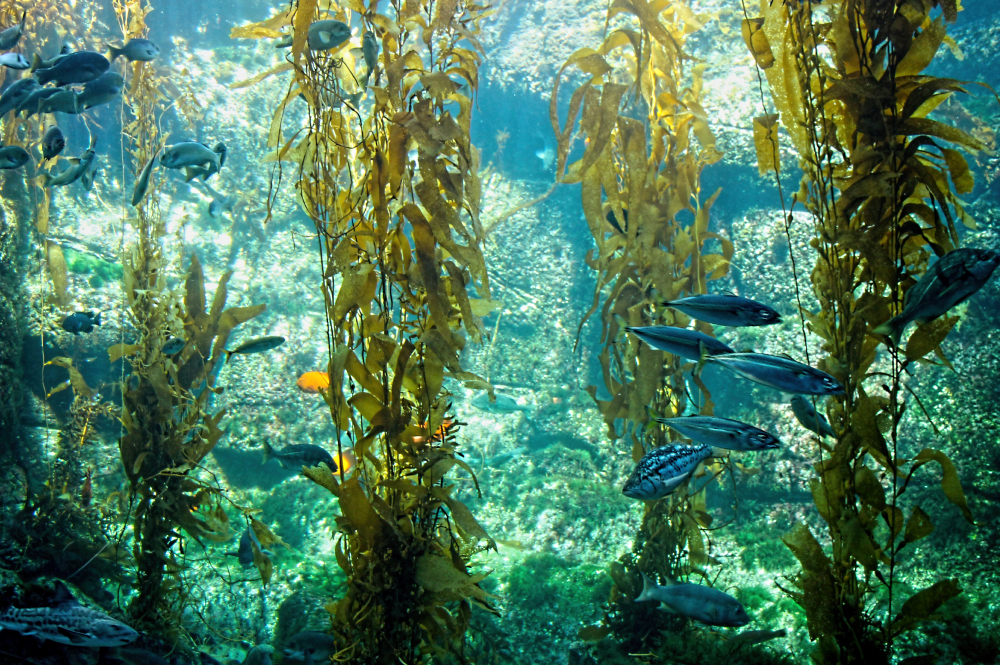Kelp Forests – The Climate Change Saviour?

Tangled in your feet when paddling in the low tides of British waters, kelp is often a hindrance met with squeals of disgust. However, this inconvenient seaweed may hold an unexpected key to mitigating the impact of climate change.
What is Kelp?
Defined as algae, kelp is distinguished as a large, brown seaweed, and with over 100 species, it comes in all shapes and sizes. Typically forming in cool waters and rocky seabed’s, the shallow water allows kelp to harvest sunlight to grow, growing in dense beds or ‘forests’. These condensed beds allow them to become a natural coastal defence, helping to protect organisms such as lobsters, sea snails, and fish to be sheltered from the harsh habitat of the coast.
How Kelp Helps the Environment
Reducing Waves
Due to its dense quality, kelp works wonders for reducing wave action. By acting as a physical structure in the water, it absorbs a portion of wave energy, thus creating a shelter to safeguard organisms and habitats. By creating calm habitats, it produces an ideal foraging site.
Additionally, it protects against coastal erosion by creating a buffer against waves, helping to protect shorelines from sediment removal.
Carbon Storage
One notable advantage of kelp is that it absorbs inorganic carbon dioxide (CO2) and converts it to organic biomass, which breaks down and is transported with the ocean currents to be eaten or decompose. So rather than storing carbon in the ground, it means kelp’s carbon storage capabilities may make an overall contribution to carbon offsetting. Studies indicate that it does have a positive effect, which is certainly preferable to having no impact at all.
Supports Marine Biodiversity
As one of the world’s fastest-growing species, kelp’s varying heights and sizes cultivate an ideal ecosystem. Its multi-layered habitat creates a canopy, from the water’s surface to the ocean floor, providing a habitat and refuge for numerous marine species.
Nutrient Dense
Kelp is nutrient-rich in vitamins such as A, B, C, and E, creating crucial resources in coastal communities and allowing them to reap the health benefits. It can be harvested and consumed in a variety of ways, both fresh and cooked, offering both flexibility and versatility.
Additionally, essential nutrients are transferred from kelp to marine organisms, forming an important link in the food chain and supporting survival of numerous species, all benefiting from the rich nutritional content found within the kelp.
In Decline
Annually, kelp is declining by ~1.8%,1 with 40% of existing forests being damaged by poor water quality and overfishing. Additionally, warmer ocean temperatures, due to Earth’s overall temperature rise, are reducing kelp’s strength and ability to withstand wave forces.
A rise in agriculture and nutrient run-off that accompanies such activities is also damaging kelp. Agricultural practices result in an overabundance of nutrients entering coastal ecosystems, disrupting the balance of the environment and creating conditions that are detrimental to kelp growth. As a result, kelp forests are suffering a decline in many regions.
Impacts of the Ocean on Climate Change
The World’s Oceans are the largest heat sink on the planet, absorbing 90% of excess heat caused by greenhouse gases.2 Our oceans also reduce CO2 levels through the vast marine environment with organisms, such as kelp, helping to delay the impact of climate change.
Outlook
Kelp forests, often overlooked, hold potential as a vital solution in the fight against climate change. However, these underwater ecosystems are facing decline, and so it is essential that we continue to protect this special species. Controlling marine herbivore populations, such as sea urchins, can help to minimise overgrazing. Planting kelp and reseeding reefs can help revitalise weakened areas and promote the recovery of these ecosystems.
Additionally, monitoring systems are needed to accurately assess the health and extent of kelp forests, with data collection to provide insights into growth rates and threats.
1 WRI
2 IFAW


